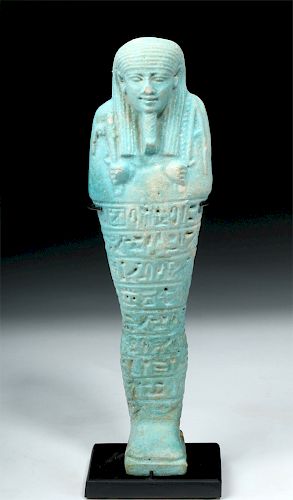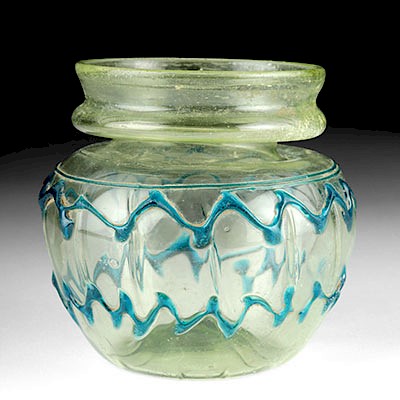Translated Egyptian Faience Ushabti for Ipethemetes
Lot 2
About Seller
Artemis Fine Arts
686 S Taylor Ave, Ste 106
Louisville, CO 80027
United States
Selling antiquities, ancient and ethnographic art online since 1993, Artemis Gallery specializes in Classical Antiquities (Egyptian, Greek, Roman, Near Eastern), Asian, Pre-Columbian, African / Tribal / Oceanographic art. Our extensive inventory includes pottery, stone, metal, wood, glass and textil...Read more
Estimate:
$5,000 - $7,500
Absentee vs Live bid
Two ways to bid:
- Leave a max absentee bid and the platform will bid on your behalf up to your maximum bid during the live auction.
- Bid live during the auction and your bids will be submitted real-time to the auctioneer.
Bid Increments
| Price | Bid Increment |
|---|---|
| $0 | $25 |
| $300 | $50 |
| $1,000 | $100 |
| $2,000 | $250 |
| $5,000 | $500 |
| $10,000 | $1,000 |
| $20,000 | $2,500 |
| $50,000 | $5,000 |
| $100,000 | $10,000 |
| $200,000 | $20,000 |
About Auction
By Artemis Fine Arts
Aug 16, 2018
Set Reminder
2018-08-16 10:00:00
2018-08-16 10:00:00
America/New_York
Bidsquare
Bidsquare : Clearance Sale - Ancient / Ethnographic Art
https://www.bidsquare.com/auctions/artemis-gallery/clearance-sale---ancient-ethnographic-art-3368
These lots are going, going, gone... plus a nice selection of lots brand-new to auction! Artemis Fine Arts info@artemisfinearts.com
These lots are going, going, gone... plus a nice selection of lots brand-new to auction! Artemis Fine Arts info@artemisfinearts.com
- Lot Description
**Originally Listed At $3500**
Ancient Egypt, Saite Period, Twenty-Sixth Dynasty (XXVI), ca. 664 to 525 BCE. An excellent example of a well-made faience ushabti, inscribed with a personal prayer of protection, indicating that it belonged to an elite woman, rather than being one of the mass produced and generic ushabti that we often see from this period. The artist who created this piece used copper to create a gorgeous sky blue faience glaze that coats the mummiform body of the ushabti. Dense hieroglyphs around its lower body form a prayer for the afterlife. Size: 2.4" W x 8.4" H (6.1 cm x 21.3 cm); 8.8" H (22.4 cm) on included custom stand.
The owner of this ushabti was a woman named Ipethemetes, the daughter of a woman named Hathoremakhet. The female personal name Ipethemetes means "(the goddess) Ipet is her mistress". The hippopotamus goddess Ipet was worshipped as mother of Osiris at Thebes. Ipet was one of several goddesses, including Taweret, Reret and Heqet, who could take the form of a hippopotamus. All of these goddesses were associated with pregnancy and protection. Ipethemetes was the designation of the twelfth month goddess in the ancient Egyptian calendar. The personal name indicates that the shabti most likely originates from Thebes. The name Hathoremakhet means "Hathor is at the horizon". Interestingly there is a contemporaneous ushabti known for a woman called Hathoremakhet whose own mother was named Tasheries.
Ushabti dolls are figures shaped like adult male or female mummies wearing traditional ancient Egyptian headdresses. The ancient Egyptians believed that after they died, their spirits would have to work in the "Field of Reeds" owned by the god of the underworld, Osiris. This meant doing agricultural labor - and it was required by all members of society, from workers to pharaohs. The wealthier nobility in Egyptian society were able to have shabtis made of faience; blue faience was meant to reflect the color of the river Nile both on earth and in the afterlife.
Provenance: private Jones collection, Boulder, Colorado, USA; acquired on the London, UK art market in 2008
All items legal to buy/sell under U.S. Statute covering cultural patrimony Code 2600, CHAPTER 14, and are guaranteed to be as described or your money back.
A Certificate of Authenticity will accompany all winning bids.
We ship worldwide and handle all shipping in-house for your convenience.
#127054Small areas of surface wear; tip of nose is lost. Expertly repaired low on the body; repair is almost impossible to see. Details are excellent, including legible hieroglyphs.Condition
- Shipping Info
-
All shipping is handled in-house for your convenience. Your invoice from Artemis Gallery will include shipping calculation instructions. If in doubt, please inquire BEFORE bidding for estimated shipping costs for individual items.
-
- Buyer's Premium



 EUR
EUR CAD
CAD AUD
AUD GBP
GBP MXN
MXN HKD
HKD CNY
CNY MYR
MYR SEK
SEK SGD
SGD CHF
CHF THB
THB
















